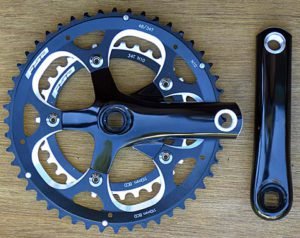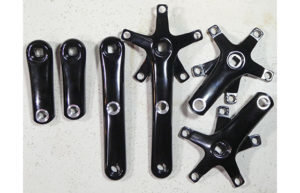By JAN WILLMS
Nokomis resident Mark Stonich is a tinkerer. And his curiosity about how things work and how they can work better has led him to a unique semi-retirement profession. He has two worldwide monopolies. He sends shortened cranks and tools all over the world.
‘’I’m the last source on the planet for a couple of tools for working on vintage bicycles,’’ he said.
Those tools are a crank cotter press, used for installing and removing the tapered pins that were used to mount old steel crank arms, and a tool for removing the crank bearing cup from old English bikes. “And I’m the only person anywhere commercially shortening bicycle cranks,” he added.
 Photo right: Mark Stonich at work in his basement workshop. (Photo by Jan Willms)
Photo right: Mark Stonich at work in his basement workshop. (Photo by Jan Willms)
A crank consists of one or more sprockets attached to the crank arms to which the pedals attach. It is connected to the rider by the pedals, to the bicycle frame by the bottom bracket, and to the rear sprocket, cassette or freewheel via the chain.
People need shortened cranks for a variety of reasons, according to Stonich. ‘’There can be a limited range of motion due to an accident, congenital disabilities, or knee surgery,’’ he said. Other reasons for needing a shorter crank include short limbs in small adults and children, dwarfism, or unequal leg lengths.
From the basement of his home where he has his business, Bike Smith Design, Stonich connects with customers from all over the world, as well as the United States. In just the first six weeks of this year, he has sent parts to Hong Kong, Singapore, Australia, New Zealand, England, and France.
One of his customers who has greatly expanded on his cycling is John ‘The Hammer’ Young. ‘’He was the first dwarf triathlete and now is quite a celebrity among the Little People community,’’ Stonich said. Stonich was first contacted by Young about ten years ago. He just wanted a bike that would fit him so he could go riding with his children. He found a 20-inch wheel REI girls MTB, and Stonich made him up some 100 mm cranks. Young said when he was finally able to ride a bike, he almost broke into tears.
‘’Six months later, he called me and asked if I could help him gear the bike higher so he could go faster,’’ Stonich recalled. ‘He said he was pretty fit for a little guy, as he was the swim coach at the school where he also taught math.’’ Six months later Young wrote that he was going to try doing a community triathlon, even though he was sure he would come in dead last. He did not finish last, and eventually a triathlon team noted that he was beating some of their participants in swimming, and they asked him to join their team and help coach swimming. In turn, they helped him with the run, filming him on a treadmill and convincing him to shorten his stride, which saved him 30-40 seconds per mile.
‘’They also helped him modify his bike until nothing original remained but the frame, brakes and my cranks,’’ Stonich said. When Young, who is from Massachusetts, had business in Albert Lea, he rented a car and strapped his homemade extenders onto the gas and brake pedals and drove 85 miles each way to take Stonich and his wife, Jane, out to lunch. This kind of connection with his customers is what makes Stonich’s craft exciting.
 Photo left: The crank and crank arm are two of the items that Stonich specializes in. (Photo submitted)
Photo left: The crank and crank arm are two of the items that Stonich specializes in. (Photo submitted)
“One morning I woke up to an email that had been sent from Japan, an hour before the Fukushima tsunami,” Stonich said. “A bike shop owner asking about a cotter press. I replied that I hoped he was okay, and I said I would understand if he wouldn’t need it until things settled down.”
“He replied ‘Now I need it more than ever. Tens of thousands of cars were destroyed. People will need to get their old bikes running again’….”
Stonich explained that 98 percent of cranks for adults are between 170 mm and 175 mm long. But adults 5'5" and under, or 6’4” and taller, are common. “Most bikes for children are sold with cranks that won’t be the right length for the child until he or she has outgrown the bike,” he said. “When your cranks are too long, your glutes and quads are stretched too much to be effective in the top half of the pedal circle. This makes cycling much more tiring than it should be, so they take up a different activity or watch Netflix.”
It takes Stonich just under an hour to shorten most cranks, but he spends an average of 5-6 hours working for every crank sold. “The hard work is gathering enough information about the customers, their bikes and the riding they do, figuring out what length and front sprocket sizes they need and which cranks will work and what, if any, adapters will be needed to the crank of their bikes,” Stonich said.
 “The actual shortening of the crank, the welding or glazing and joining tubes, that’s the fun part and only takes ten percent of your time. But when you have that torch in your hand, that’s some sort of nirvana for people like me.”
“The actual shortening of the crank, the welding or glazing and joining tubes, that’s the fun part and only takes ten percent of your time. But when you have that torch in your hand, that’s some sort of nirvana for people like me.”
As a child, Stonich said he would have liked to tinker but never really had the chance. “We were dirt poor, about the poorest family in a pretty lower-middle-class town. I was born in Duluth, but my parents were living in Grand Rapids at the time on a forestry station.”
As a teenager, Stonich had a job and wanted a car, but his dad would not allow him to have one. “Back then, a bike for a teenager was a shameful thing, like riding a toy. So I built up a bike from scrap parts to embarrass my dad into buying me a car, and it worked. He got me a car.”
But Stonich’s bike riding continued, and a few years later he was at a party in Duluth where he met a girl. “She needed a ride home, but she thought we were all too drunk to drive. However, she was desperate to get home, and we went outside, and I pulled out a bike. I folded my serape and put it on the rear rack for her to ride on. As we rode along, I thought this girl was such a good sport. We rode a mile, and she said to make a left and it was straight up a hill. We walked the rest of the way to her home. And now we have a great grandson who is a senior in high school. We have worn out three touring motorcycles and are on our seventh tandem bike. We still ride together a lot.”
The two shoot a lot of photos while on their bike rides. “Photography is a hobby, but biking is my life,” Stonich said.
“The beautiful thing about what I do is that while special needs folks usually need more of my time, they end up with my cheapest cranks. Triathletes and racers will spend anywhere from $219 to over $700. So helping upper-middle-class white folks go even faster, subsidizes helping people who otherwise wouldn’t’ be able to ride at all.”
Two of the most satisfying things in life, according to Stonich, are problem-solving and making a difference in someone’s life. He said one of his rare Minnesota customers loved riding her bike, but was hit by a car and her knee was badly damaged, severely restricting her range of motion. The bike was unharmed but put away for 30 years before someone told the woman about Stonich’s services.
“I installed a set of 100 mm cranks on her bike, and she rode right off. They say you never forget how to ride a bike, and apparently, that’s true. She rode down our street, made a U-turn and returned crying like a baby. She wouldn’t stop hugging us.”
Stonich said the nice thing about being semi-retired is that he can spend a sunny Wednesday outside on his bike and spend time in his workshop on a Sunday night.
“At 72, I’d love to have more time for travel and photography,” Stonich said. “But as long as there is no one else to help those with special needs, I can’t quit.”
Comments
No comments on this item Please log in to comment by clicking here